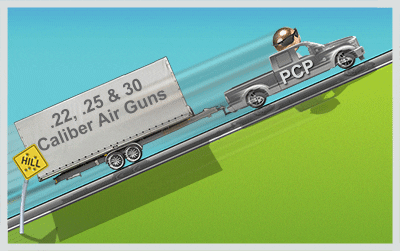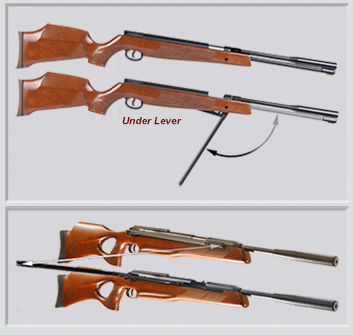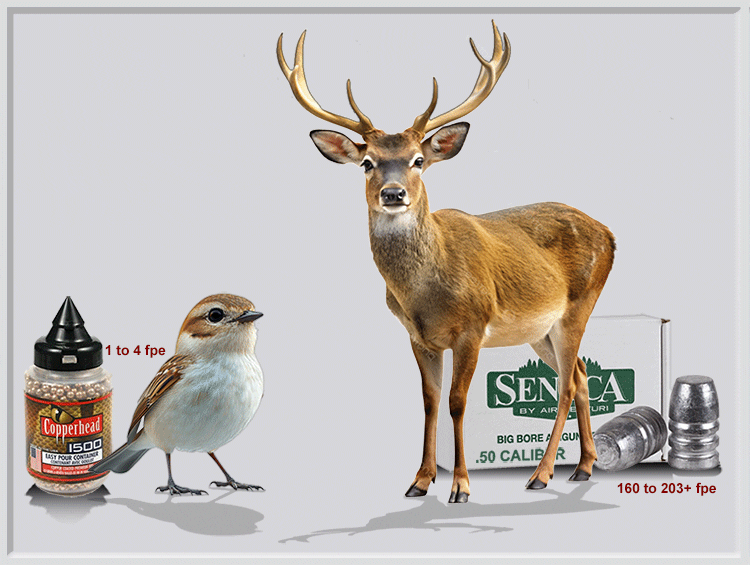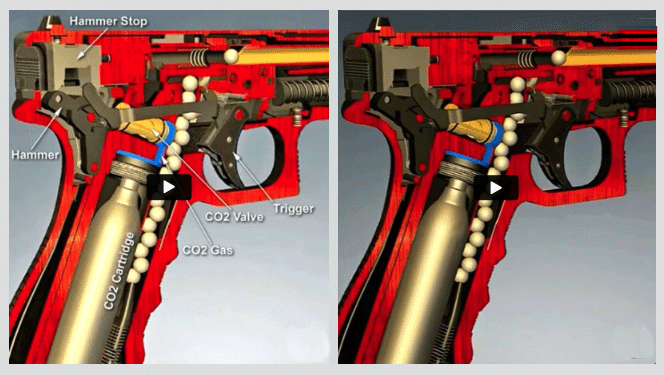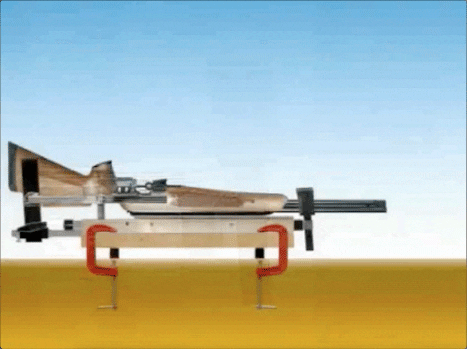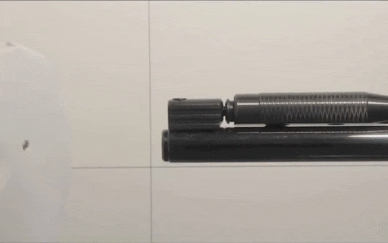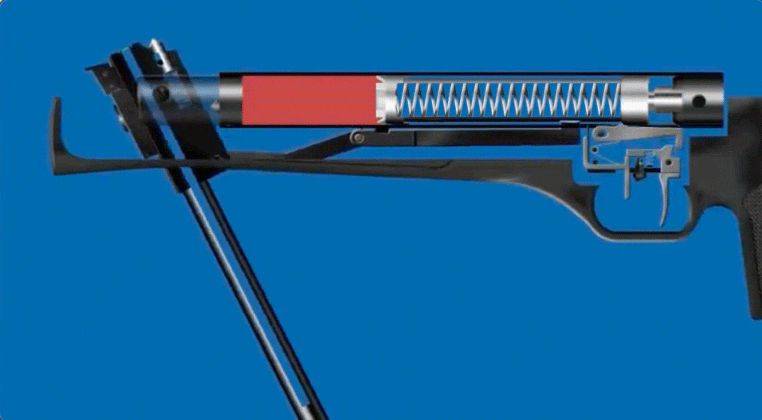Gas-Piston Air Guns Achieve Power by Compressing an Inert Gas Cylinder
(Crows, Cotton Tail Rabbits, Skunks, Tree Squirrels, Coots, Mergansers, Rats, Pigeons, Barn Swallows, Starlings).
Gas-Piston air guns achieve power by compressing an inert gas cylinder to a locking point called a trigger sear. As the inert gas is compressed inside the cylinder, a seal that is mounted on the front of the cylinder pulls in ambient air. When released by the trigger sear the compressed inert gas snaps the cylinder forward to its relaxed position and the ambient air is pushed out of the cylinder guide chamber by the front seal sending the pellet forward out of the gun barrel towards the target.
In many cases the cocking is done by the barrel itself, however, separate side levers and under levers are common allowing the barrel to stay fixed.
To overcome the resistance of a relaxed inert gas cylinder and compress It to create tension requires a measured amount of force referred to as “cocking effort” or pounds of force. A gas cylinder with less inert gas will require less cocking effort than a gas cylinder with more inert gas.
Gas-Piston Air Guns have four levels of spring coil thickness:
- 21 to 30 pounds of easy cocking effort
- Less than Original (Stock) amount of inert gas designed for this unit
- Same gas cylinder equals same power for .177, .22 and .25 calibers
- .177 caliber: accuracy yes- with light weight pellets
- .22 caliber: accuracy no- pellets too heavy!
- .25 caliber: accuracy no- pellets way too heavy!
- Beginner or youth air gunners
- Up to 14 ft/lbs of energy (FPE)
- Power for plinking and killing tin cans
- 31 to 40 pounds of average strength cocking effort
- Original (Stock) amount of inert gas designed for this unit
- Same gas cylinder equals same power for .177, .22 and .25 calibers
- .177 caliber: accuracy yes- with medium weight pellets
- .22 caliber: accuracy possible- with very light weight pellets!
- .25 caliber: accuracy no- pellets way too heavy!
- Target and small pest control purchased by the majority of air gunners
- 14 to 24 foot pounds of energy (FPE)
- Authoritative knock-down power for animals up to 5 pounds
- 41 to 50 pounds of above average strength cocking effort
- More than Original (Stock) amount of inert gas designed for this unit
- Same gas cylinder equals same power for .177, .22, .25 and ,30 calibers
- .177 caliber: accuracy possible- with very light weight pellets
- .22 caliber: accuracy yes- with medium weight pellets!
- .25 caliber: accuracy no- pellets too heavy!
- .30 caliber: accuracy no- pellets way too heavy!
- Target and small to medium pest control for strong air gunners
- 25 to 30 foot pounds of energy (FPE)
- Possible Authoritative knock-down power for animals 6 to 10 pounds*
- 51 to 60 pounds of brute strength cocking effort
- More yet than Original (Stock) amount of inert gas designed for this unit
- Same gas cylinder equals same power for .22, .25 and .30 calibers
- .22 caliber: accuracy possible- with very light weight pellets
- .25 caliber: accuracy maybe- with light weight pellets
- .30 caliber: accuracy no- pellets way too heavy!
- Target and small to medium pest control for brute strength air gunners
- 30 to 35 foot pounds of energy (FPE)
- Possible Authoritative knock-down power for animals 10 to 15 pounds**
- *PCP .22 & .25 caliber: Authoritative Knock-Down Power for Animals 6 to 14 lbs.
- **PCP .25 & 30 caliber: Authoritative Knock-Down Power for Animals 15 to 24 lbs
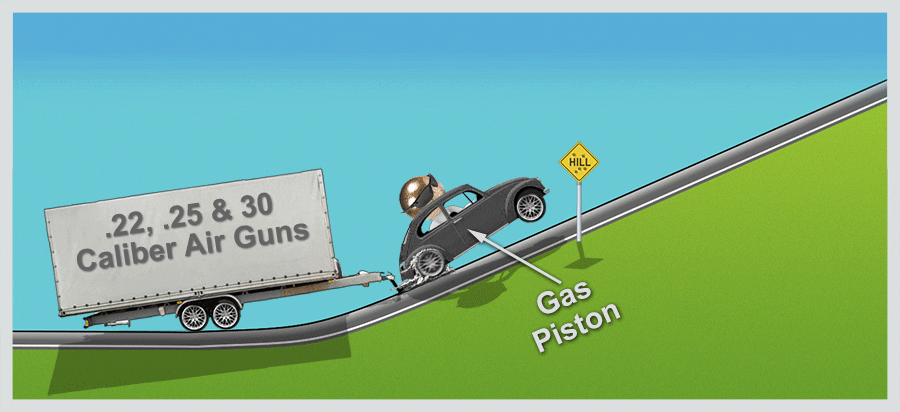
In short, expecting accuracy and power out of any .22, .25 or .30 gas-piston air gun is like a 50 HP 4 cylinder Volkswagen Beetle trying to pull a loaded cargo trailer up a hill and expecting the same performance as a 500 HP big block V8 pickup pulling the same loaded cargo trailer up the same hill.
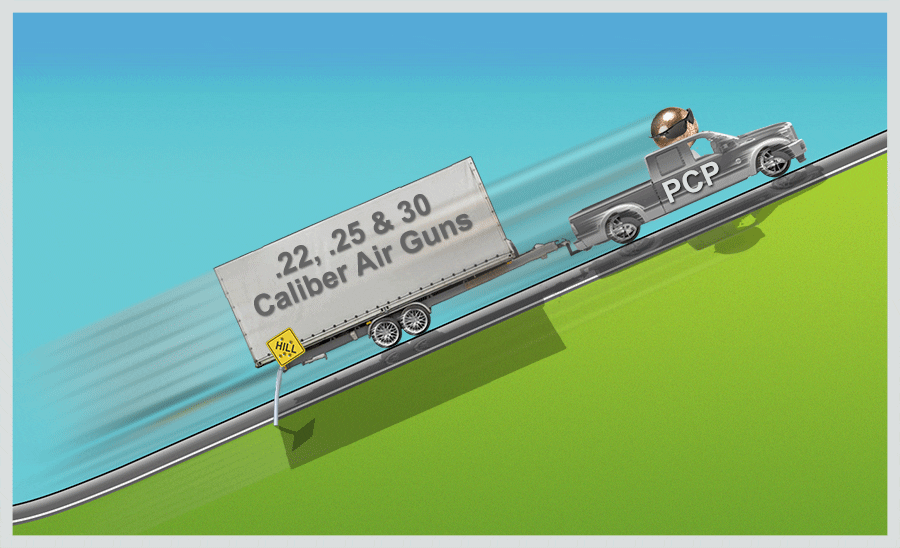
Gas-Piston Air Guns Achieve Power by Compressing an Inert Gas Cylinder
Authoritative Knock-Down Power for Animals up to 5lbs.
(Crows, Cotton Tail Rabbits, Skunks, Tree Squirrels, Coots, Mergansers, Rats, Pigeons, Barn Swallows, Starlings).
Gas-Piston air guns achieve power by compressing an inert gas cylinder to a locking point called a trigger sear. As the inert gas is compressed inside the cylinder, a seal that is mounted on the front of the cylinder pulls in ambient air. When released by the trigger sear the compressed inert gas snaps the cylinder forward to its relaxed position and the ambient air is pushed out of the cylinder guide chamber by the front seal sending the pellet forward out of the gun barrel towards the target.
In many cases the cocking is done by the barrel itself, however, separate side levers and under levers are common allowing the barrel to stay fixed.
To overcome the resistance of a relaxed inert gas cylinder and compress It to create tension requires a measured amount of force referred to as “cocking effort” or pounds of force. A gas cylinder with less inert gas will require less cocking effort than a gas cylinder with more inert gas.
Gas-Piston Air Guns have four levels of spring coil thickness:
- 21 to 30 pounds of easy cocking effort
- Less than Original (Stock) amount of inert gas designed for this unit
- Same gas cylinder equals same power for .177, .22 and .25 calibers
- .177 caliber: accuracy yes- with light weight pellets
- .22 caliber: accuracy no- pellets too heavy!
- .25 caliber: accuracy no- pellets way too heavy!
- Beginner or youth air gunners
- Up to 14 ft/lbs of energy (FPE)
- Power for plinking and killing tin cans
- 31 to 40 pounds of average strength cocking effort
- Original (Stock) amount of inert gas designed for this unit
- Same gas cylinder equals same power for .177, .22 and .25 calibers
- .177 caliber: accuracy yes- with medium weight pellets
- .22 caliber: accuracy possible- with very light weight pellets!
- .25 caliber: accuracy no- pellets way too heavy!
- Target and small pest control purchased by the majority of air gunners
- 14 to 24 foot pounds of energy (FPE)
- Authoritative knock-down power for animals up to 5 pounds
- 41 to 50 pounds of above average strength cocking effort
- More than Original (Stock) amount of inert gas designed for this unit
- Same gas cylinder equals same power for .177, .22, .25 and ,30 calibers
- .177 caliber: accuracy possible- with very light weight pellets
- .22 caliber: accuracy yes- with medium weight pellets!
- .25 caliber: accuracy no- pellets too heavy!
- .30 caliber: accuracy no- pellets way too heavy!
- Target and small to medium pest control for strong air gunners
- 25 to 30 foot pounds of energy (FPE)
- Possible Authoritative knock-down power for animals 6 to 10 pounds*
- 51 to 60 pounds of brute strength cocking effort
- More yet than Original (Stock) amount of inert gas designed for this unit
- Same gas cylinder equals same power for .22, .25 and .30 calibers
- .22 caliber: accuracy possible- with very light weight pellets
- .25 caliber: accuracy maybe- with light weight pellets
- .30 caliber: accuracy no- pellets way too heavy!
- Target and small to medium pest control for brute strength air gunners
- 30 to 35 foot pounds of energy (FPE)
- Possible Authoritative knock-down power for animals 10 to 15 pounds**
- *PCP .22 & .25 caliber: Authoritative Knock-Down Power for Animals 6 to 14 lbs.
- **PCP .25 & 30 caliber: Authoritative Knock-Down Power for Animals 15 to 24 lbs
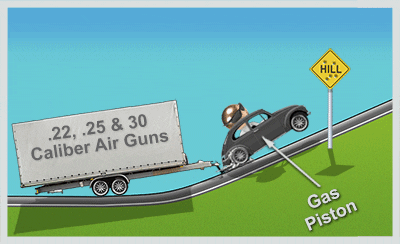
In short, expecting accuracy and power out of any .22, .25 or .30 gas-piston air gun is like a 50 HP 4 cylinder Volkswagen Beetle trying to pull a loaded cargo trailer up a hill and expecting the same performance as a 500 HP big block V8 pickup pulling the same loaded cargo trailer up the same hill.
